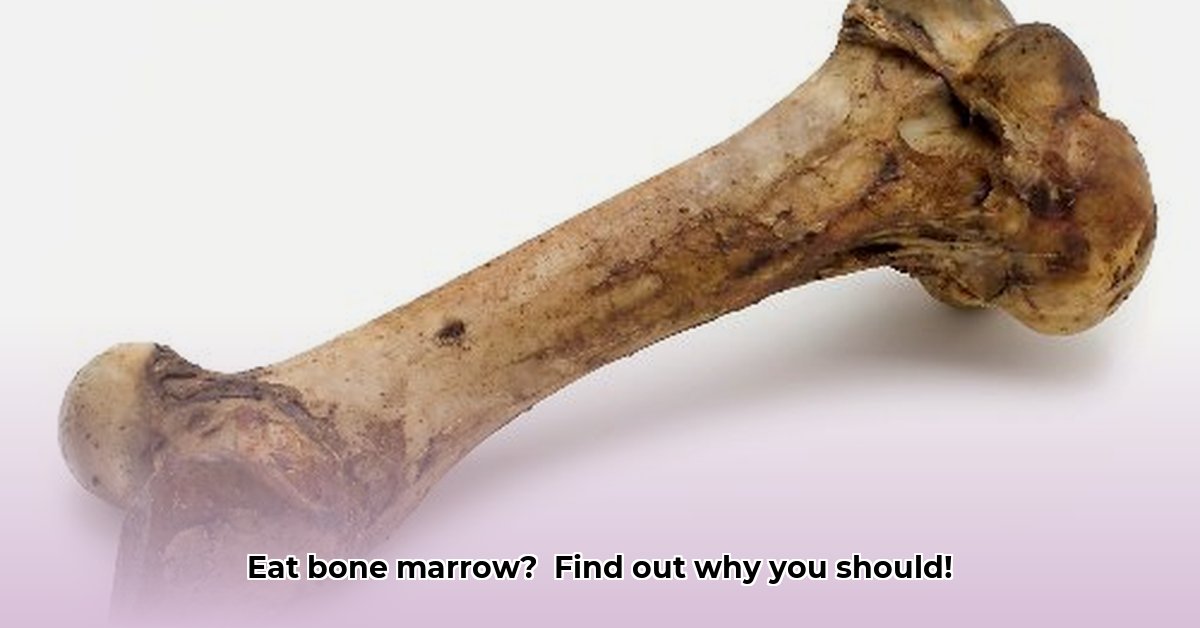Bone marrow has been a food source for centuries, prompting questions about its health benefits. For more on healthy eating, check out this article on trout. This article comprehensively examines bone marrow’s nutritional value, health benefits, potential risks, and culinary applications, enabling informed decisions about adding it to your diet.
Is Bone Marrow Healthy to Eat? A Nutritional Deep Dive
Bone marrow, while often overlooked, presents interesting nutritional aspects. This section explores the potential health benefits and risks associated with its consumption.
Unpacking Bone Marrow’s Nutritional Profile
Bone marrow is a nutrient-rich food, containing both beneficial and less desirable components. It is naturally high in fat, with its composition varying depending on several factors including the animal itself, its age, and its diet. The marrow contains a good amount of protein, and boasts vitamins like B12 (crucial for nerve function and red blood cell production), as well as minerals like calcium, iron, and phosphorus.
Furthermore, it contains compounds such as conjugated linoleic acid (CLA), which some studies have linked to health benefits, and alkylglycerols, which may boost the immune system. However, research into these compounds and their effects is ongoing.
On the less desirable side, bone marrow is high in fat and cholesterol, a key concern for those monitoring cholesterol levels, as high cholesterol can increase the risk of heart disease. The cholesterol content can vary significantly depending on the animal’s diet, age, and breed.
Potential Upsides: Health Benefits (With a Grain of Salt)
Research suggests potential health benefits from bone marrow consumption. The collagen content could support joint health and improve skin health, while alkylglycerols may boost the immune system. Some studies also suggest potential anti-inflammatory effects from compounds like conjugated linoleic acid (CLA).
However, this evidence primarily comes from animal studies and smaller human trials. More extensive human studies are needed to confirm these claims and fully understand the extent of these potential benefits.
Understanding the Potential Downsides: Risks to Consider
Bone marrow consumption is not without risk. The high fat and cholesterol content is a significant concern, especially for individuals managing cholesterol levels or at risk of heart disease. Moderation and awareness are key.
Heavy metal contamination is another risk factor, dependent on the animal’s diet, where it was raised, and its age. Bones can accumulate heavy metals like lead and cadmium from the environment. Animals raised on pasture and organic feed are generally less likely to be contaminated compared to those raised conventionally, but testing and sourcing transparency are still important.
Additionally, although rare, allergic reactions to bone marrow are possible, so proceed with caution if you have known food allergies or sensitivities to animal products.
Cooking and Sourcing Bone Marrow: Making Smart Choices
Bone marrow is versatile and can be roasted to bring out its rich flavor, used to make bone broth (a nutrient-rich liquid with potentially lower fat content depending on preparation), or incorporated into sauces and stews. The cooking method significantly influences its nutritional value and fat content.
Sourcing is crucial, so opt for bone marrow from organic, grass-fed animals whenever possible to minimize exposure to heavy metals and ensure a cleaner, nutrient-rich product. Look for suppliers with transparent sourcing practices.
The Bottom Line: Informed Decisions for Your Health
Determining whether bone marrow is healthy depends on various factors. It offers notable nutritional benefits but also presents potential downsides. Consider these guidelines for responsible consumption:
- Consider your personal health situation: Consult your doctor or a registered dietitian if you have cholesterol or heart health concerns, or if you have any pre-existing health conditions.
- Choose your sources wisely: Opt for organic, grass-fed bone marrow from reputable suppliers with transparent sourcing practices.
- Practice moderation: Due to the high fat and cholesterol content, moderation is crucial. Consider smaller portion sizes.
- Be aware of potential allergies: Take precautions if you have known food sensitivities or allergies. Introduce bone marrow slowly into your diet to monitor for any adverse reactions.
Responsible consumption involves making informed choices aligned with your health goals and dietary needs. Bone marrow can be a valuable addition to a healthy diet, but it is not a universal solution for health, and should be considered alongside other dietary and lifestyle factors.
Bone Marrow Nutritional Profile (Per 100g): Approximate Values
| Nutrient | Amount |
|---|---|
| Calories | ~350 |
| Fat | ~31g |
| Saturated Fat | ~12g |
| Cholesterol | ~200mg |
| Protein | ~10g |
| Collagen | Variable |
| Vitamin B12 | Significant |
| Iron | Moderate |
| Other Minerals | Varies |
Disclaimer: These values are estimates and can vary significantly based on factors such as the animal’s diet, age, and breed. Always consult reputable nutritional databases and consider lab testing data from your specific supplier for more accurate information.
How to Minimize Heavy Metal Contamination in Homemade Bone Marrow Dishes
Bone marrow, while nutrient-rich, carries potential risks, including heavy metal contamination. This section offers strategies for minimizing this risk when preparing bone marrow dishes at home.
Understanding the Risk
Heavy metals (e.g., lead and cadmium) can accumulate in animal bones and leach into the marrow during cooking. The amount of contamination varies based on the animal’s diet, age, cooking time, and temperature, as well as the environmental conditions in which the animal was raised.
Sourcing Matters
Choosing reputable suppliers is paramount. Look for transparency in sourcing practices and prioritize pasture-raised or grass-fed animals raised in environments with low levels of pollution. Ask suppliers about their testing protocols for heavy metals.
Cooking Techniques: A Key Strategy
While research is ongoing, some evidence suggests that minimizing overly long cooking times and extremely high temperatures may help reduce the release of heavy metals from the bone. Shorter cooking times may be preferable.
Preparation and Handling
Thoroughly clean bones before cooking to remove surface contamination. Use a stiff brush and rinse the bones under cold running water. Soaking the bones in cold water for several hours (changing the water periodically) may also help draw out impurities. The bone itself might not be completely free of metals, but this process can limit what ends up in your dish.
Balanced Perspective
Bone marrow contains beneficial nutrients like collagen, vitamins, and minerals. Balance these benefits against potential risks through moderate consumption and careful sourcing. Consulting with a nutritionist can help you integrate bone marrow into a balanced diet safely.
Key Takeaways:
- The source of bones significantly impacts heavy metal content. Choose pasture-raised animals from reputable suppliers with transparent sourcing practices.
- Careful cooking techniques minimize heavy metal leaching. Avoid excessive cooking times and high heat.
- Thorough cleaning of bones before cooking reduces surface contamination.
- Moderate bone marrow consumption as part of a balanced diet helps mitigate risks.
Community-Verified Recipes For Delicious And Healthy Bone Marrow
Bone marrow is not just a culinary curiosity, but also a nutritional element and a source of diverse recipes.
Key Takeaways:
- Bone marrow is source of collagen, vitamins (A, B12, E), and minerals (iron, phosphorus, calcium).
- It requires consumption due to its fat and cholesterol content.
- Grass-fed, organic bone marrow is for sourcing.
- Preparation methods affect flavor and nutritional value.
- Community-verified recipes provide ways to enjoy bone marrow.
Bone Marrow’s
Bone marrow is a source of collagen (important for joints and skin), vitamins like A, B12, and E, and minerals like iron, phosphorus, and calcium. Be mindful of its fat and cholesterol content, and adjust quantities according to your dietary needs.
Sourcing and Sustainability: The Ethical Choice
Opt for organic, grass-fed sources to ensure a product free from potential contaminants and to support sustainable practices.
Cooking with Bone Marrow: Unlocking Flavor and Texture
Roasting brings out its richness, while grilling adds a smoky char.
Community-Verified Recipes For Delicious And Healthy Bone Marrow
Here are some community-verified recipes to get you started:
- Roasted Bone Marrow with Herbs: Roast bone marrow until tender; top with fresh herbs like parsley, thyme, and rosemary; sea salt; and black pepper. Serve with crusty bread.
- Bone Marrow Broth: Simmer bones for hours to extract flavor and nutrients. Use as a base for soups, stews, or sauces. Add aromatic vegetables like onions, carrots, and celery, along with herbs and spices, for added flavor and nutritional value.
- Bone Marrow Toast: Spread roasted bone marrow on toast for a satisfying appetizer. Garnish with sea salt, cracked black pepper, and a sprinkle of fresh herbs. Consider adding a drizzle of balsamic glaze for a touch of sweetness and acidity.
Weighing the Pros and Cons
| Pros | Cons |
|---|---|
| Rich in collagen, vitamins, and minerals | High in saturated fat and cholesterol |
| Delicious and versatile in cuisine | Potential heavy metal contamination (from source) |
| Supports bone and joint health | Requires consumption and sourcing |
Navigating the Nutritional Landscape
is key. Bone marrow is a addition to a balanced diet.
[https://vitaminsforwoman.com/bone-health/bone-marrow
- The Best Bento Box Price For Your Perfect Packed Lunch - December 15, 2025
- Bento Box Shopping Tips for Smart and Stylish Lunch Prep - December 14, 2025
- Bento Box Trays Streamline Restaurant Meal Presentation and Transport - December 13, 2025










